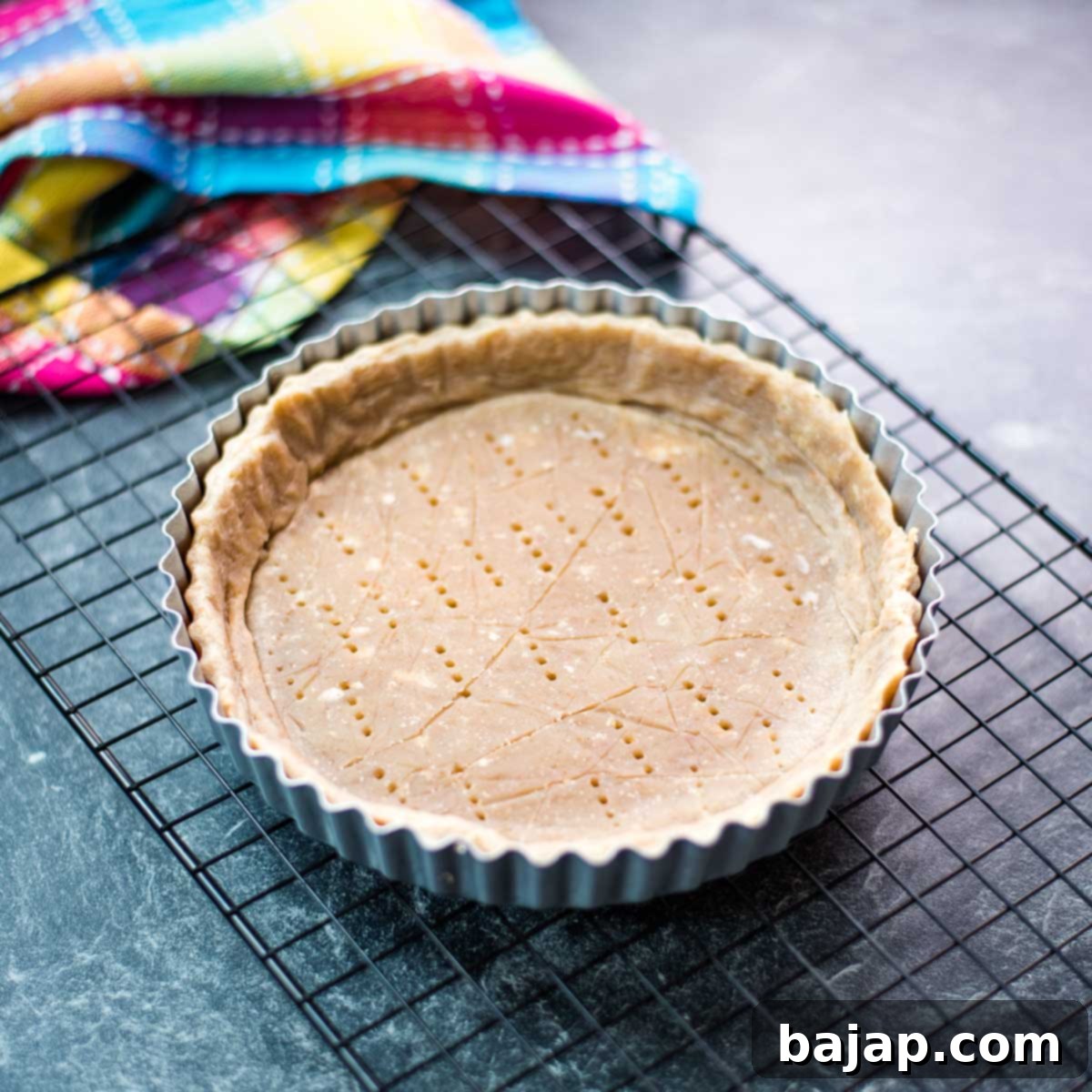Easy & Delicious Walnut Tart Crust Recipe: Your Guide to a Flaky, Flavorful Base
Are you ready to elevate your baking? Whether you’re a seasoned baker looking for a new twist or just starting your culinary journey, this homemade walnut tart crust recipe is an absolute game-changer. It’s not just any tart crust; it’s a foundation for countless sweet and savory delights, offering a unique nutty flavor and satisfying crunch that a plain crust simply can’t match.
For me, this flaky, perfectly balanced walnut tart crust is the secret ingredient behind my famous custard apple tart – a recipe I can’t wait to share with you soon! But don’t limit yourself; the rich, earthy notes of walnuts complement an astonishing array of fillings, from creamy fruit custards to decadent chocolate ganaches, and even savory quiches.
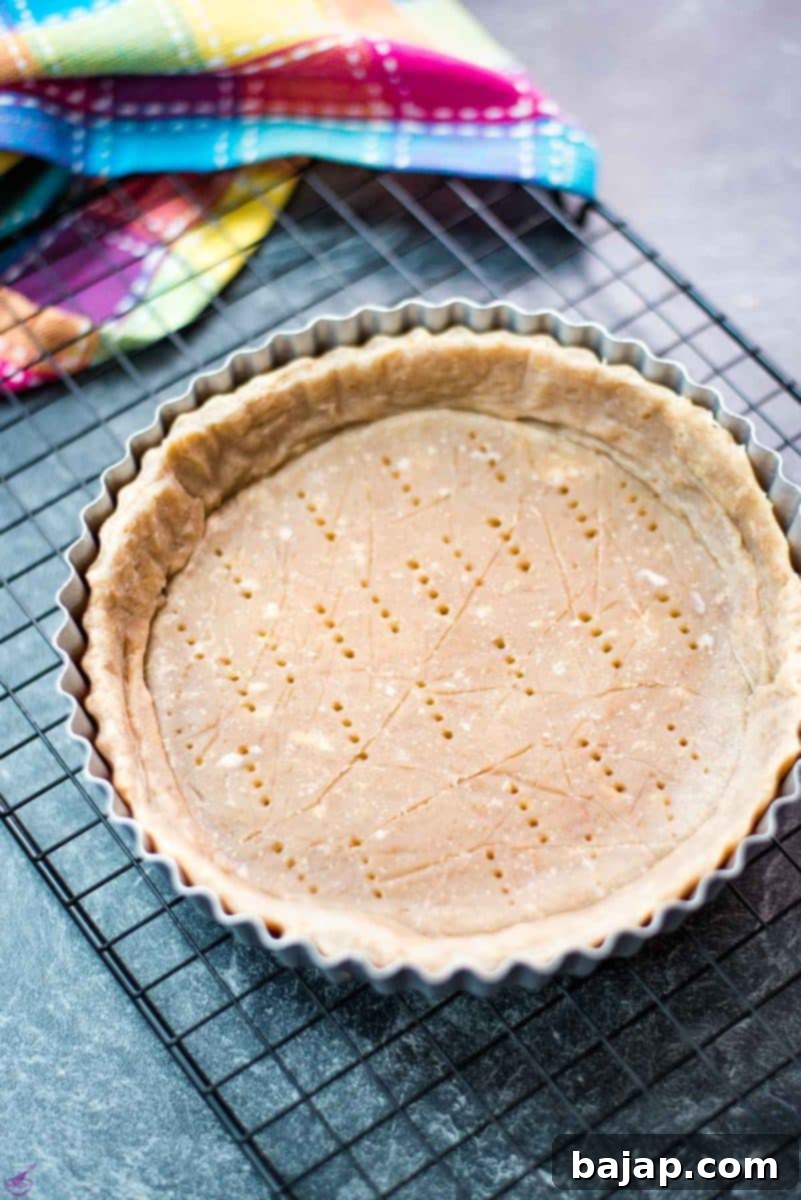
This simple walnut tart crust recipe is designed to be straightforward and accessible, ensuring even beginner bakers can achieve a powerful punch of walnut flavor and a wonderfully tender texture in every bite. One of its best features? Its incredible versatility! This delightful crust can seamlessly substitute for recipes that call for a blind-baked crust (meaning it’s cooked separately before adding the filling).
I know, I know – adding an extra step like blind baking might seem daunting, especially for busy individuals. As a mom, I totally get that some days, the energy just isn’t there. But trust me on this: if you’re up for a little extra effort, the reward is absolutely worth it! A perfectly blind-baked walnut tart crust prevents soggy bottoms and gives your tarts a professional finish, elevating every dish from good to truly extraordinary. This guide will walk you through both options, so you can choose what best fits your schedule and recipe needs.
[feast_advanced_jump_to]
🥘 Ingredients for Your Perfect Walnut Tart Crust
Creating a truly magnificent walnut tart crust starts with high-quality, fresh ingredients. The beauty of this recipe lies in its simplicity, but each component plays a vital role in achieving that desirable flaky texture and rich, nutty flavor. Make sure your butter is well-chilled – this is a non-negotiable step for a tender crust!
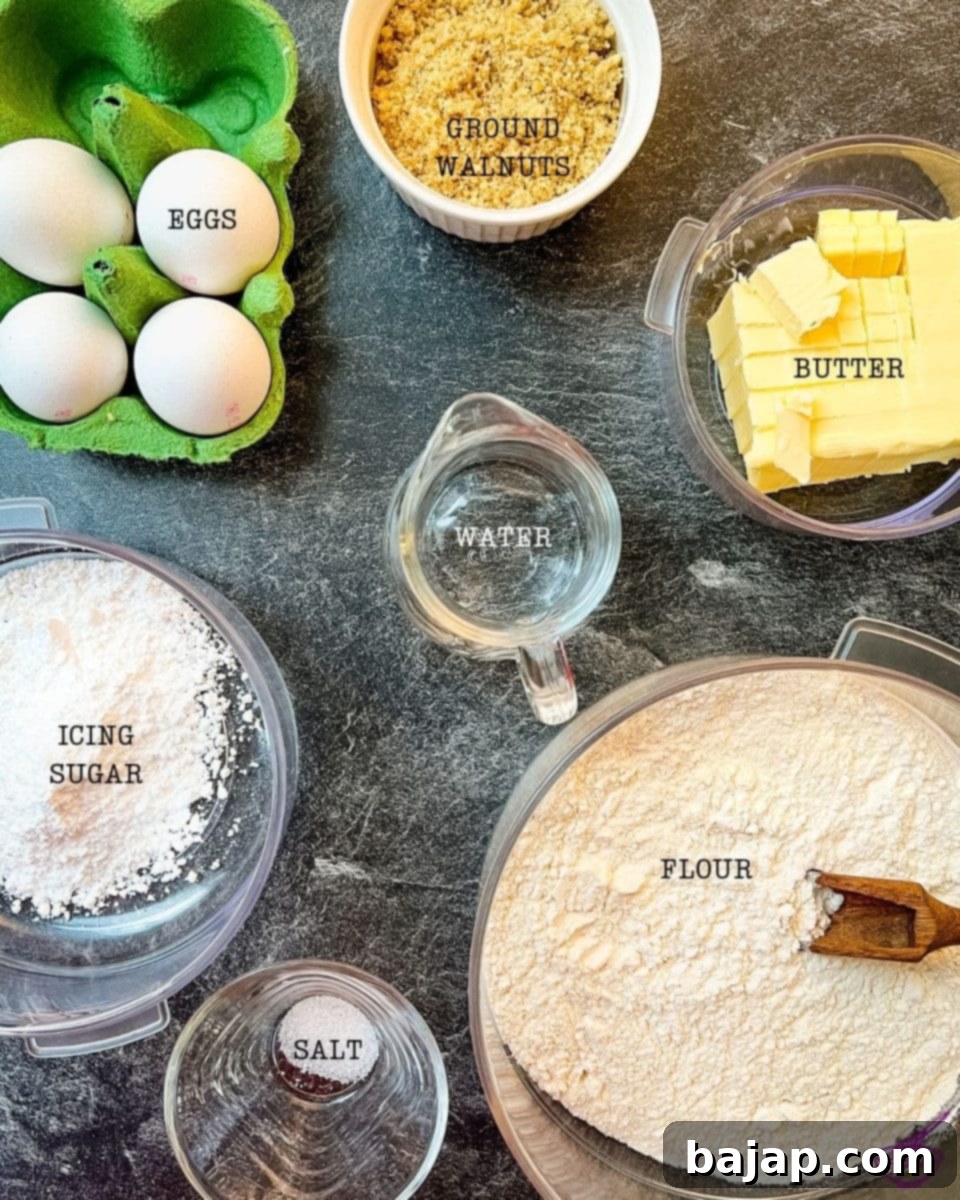
- All-Purpose Flour – sieved for a lighter texture
- Icing Sugar – for that subtle sweetness and delicate crumb
- Salt – a pinch to enhance all the flavors
- Butter (unsalted, and very cold!) – crucial for flakiness
- Walnuts – finely grated for even distribution and intense flavor
- Egg Yolks – for richness and binding
- Water (ice cold) – to bring the dough together without overworking
For precise quantities and measurements, please refer to the comprehensive recipe card below.
🔪 Step-by-Step Guide to Crafting Your Walnut Tart Crust
Follow these detailed instructions carefully to achieve a perfect, flaky, and flavorful homemade walnut tart crust every time. Precision and patience are your best friends here!
- **Prepare the Dry Ingredients:** Begin by sieving your all-purpose flour and icing sugar into a large mixing bowl. This crucial step removes any lumps, aerates the flour, and ensures a wonderfully tender and smooth dough. Don’t skip it!
- **Create a Well & Add Salt:** Once sieved, gently push the dry mixture to the sides of the bowl, forming a “well” or a small “volcano” shape in the center. Add your salt into this well.
- **Incorporate Cold Butter:** Take your chilled, unsalted butter and cut it into small, even cubes. The colder the butter, the flakier your tart crust will be. Add these cold butter cubes directly into the center well with the salt.
- **Working the Butter into the Flour (The “Sabler” Method):** Now for the fun part! Using just your fingertips, begin working the flour into the cold butter. The goal is to “squeeze” each butter cube with flour, effectively breaking down the butter into smaller, pea-sized pieces coated in flour. This process, often called “sabler” in French baking, is vital for creating a crumbly mixture. It will take some time, but it’s important to work quickly to prevent the butter from melting from the warmth of your hands. You’ll know it’s ready when the mixture resembles coarse breadcrumbs and holds together slightly when compressed in your hand.
- **Add Wet Ingredients & Walnuts:** Create another small well in the center of your flour and butter mixture. Into this well, add your egg yolks, the finely grated walnuts, and the ice-cold water.
- **Forming the Dough:** Gently begin to work all the ingredients together to form a cohesive dough. You can use your hands or a kitchen machine fitted with a paddle attachment on a low speed. The key here is **not to overwork the dough**. Overworking develops the gluten in the flour, which will result in a tough, unpleasantly chewy crust that is prone to cracking during baking. Mix just until the dough comes together.
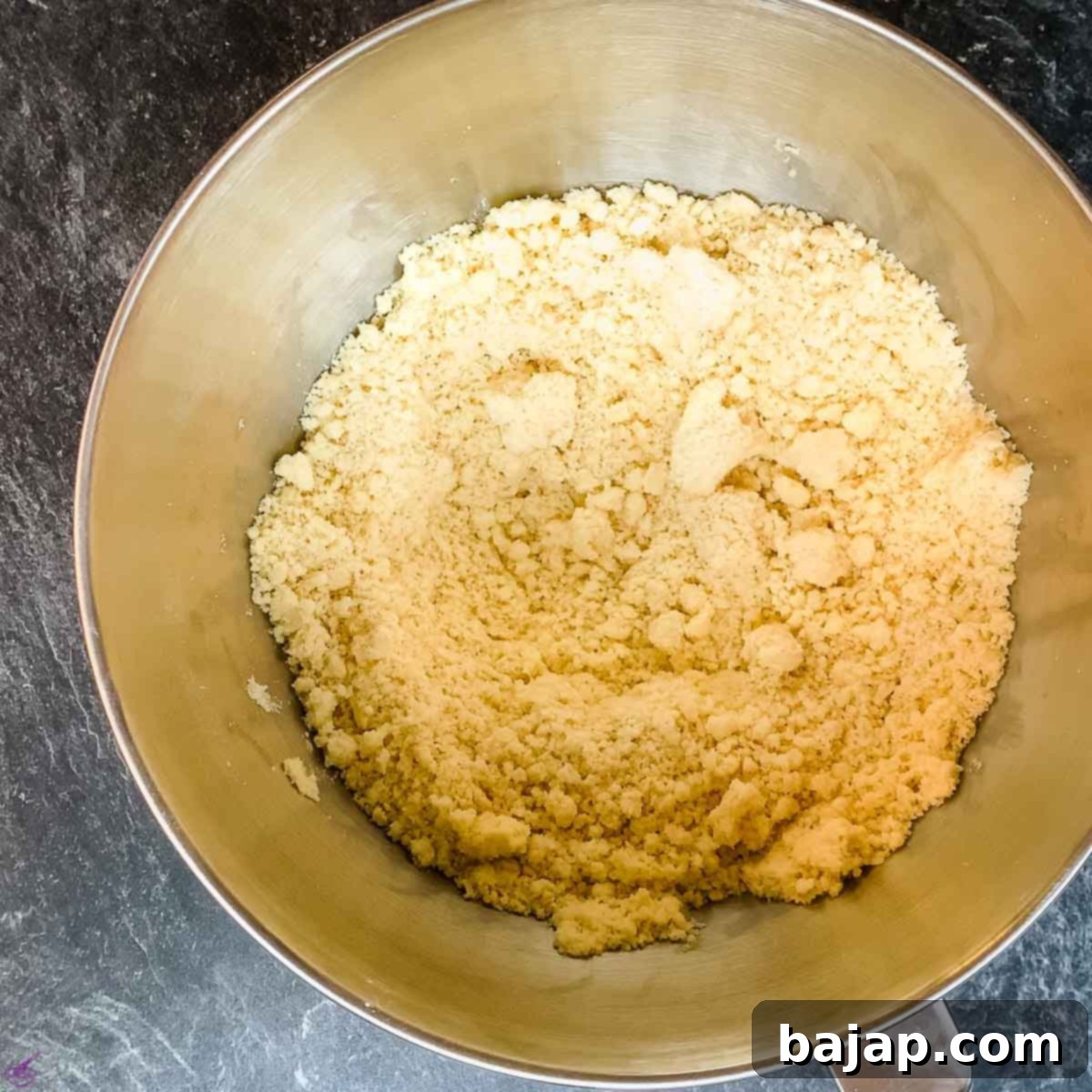
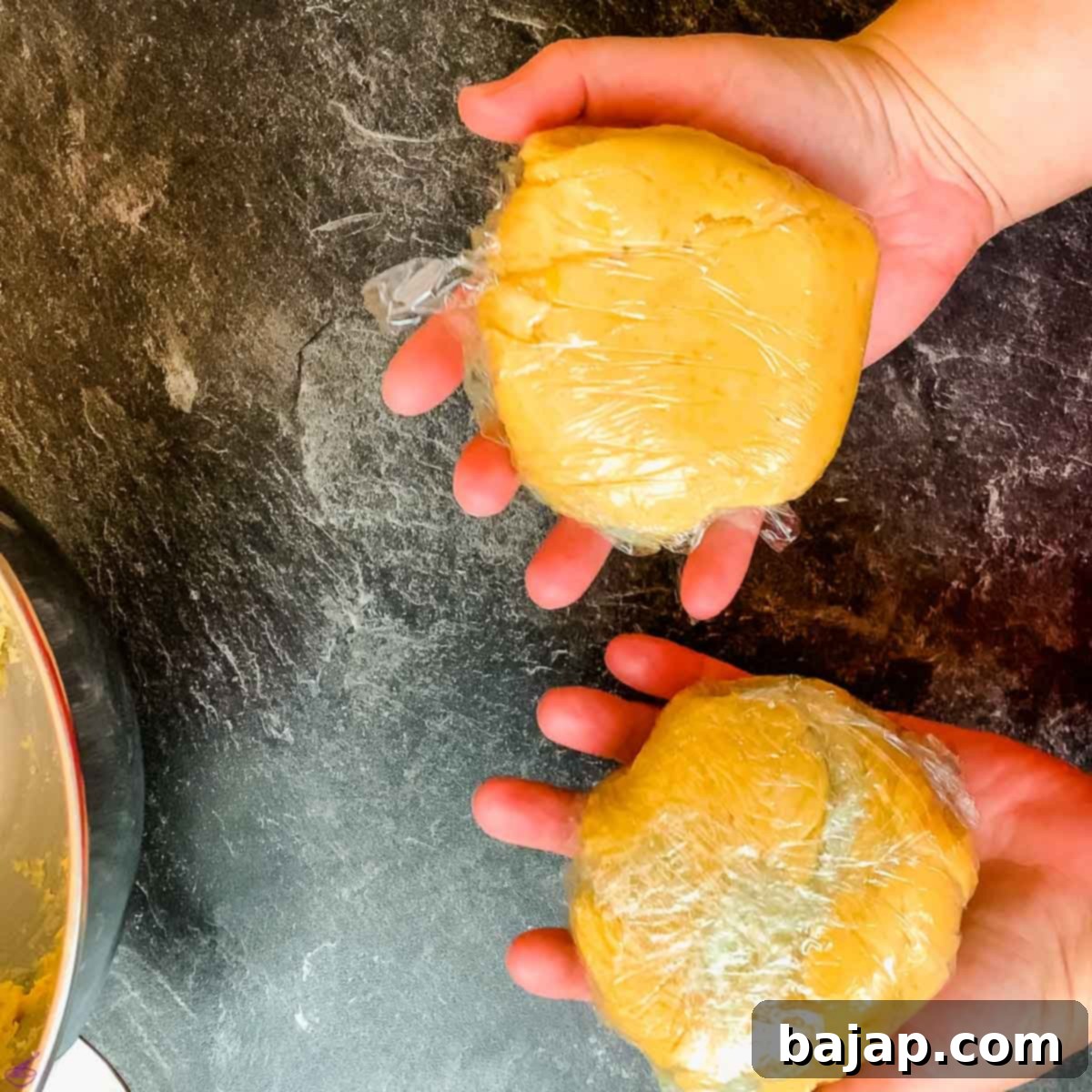
- **Chill the Dough:** Once your dough has just come together, divide it into two equal balls. Flatten each ball slightly into a disc shape (this makes rolling easier later), wrap them tightly in cling film, and refrigerate for at least one hour. Chilling allows the gluten to relax and the butter to firm up, making the dough much easier to roll and preventing shrinkage during baking.
- **Roll Out the Base:** After chilling, remove one dough ball from the fridge. Place it between two sheets of baking paper – this prevents sticking and reduces the need for extra flour, which can make the crust tough. Using a rolling pin, roll the dough evenly to a thickness of about 3-4mm (approximately 0.1 inch). If you notice any small cracks while rolling, simply press them together gently with your fingers. Use a cake pan ring or the base of your tart pan as a guide to cut out the bottom of your tart crust. Carefully transfer this round to the bottom of your tart pan.
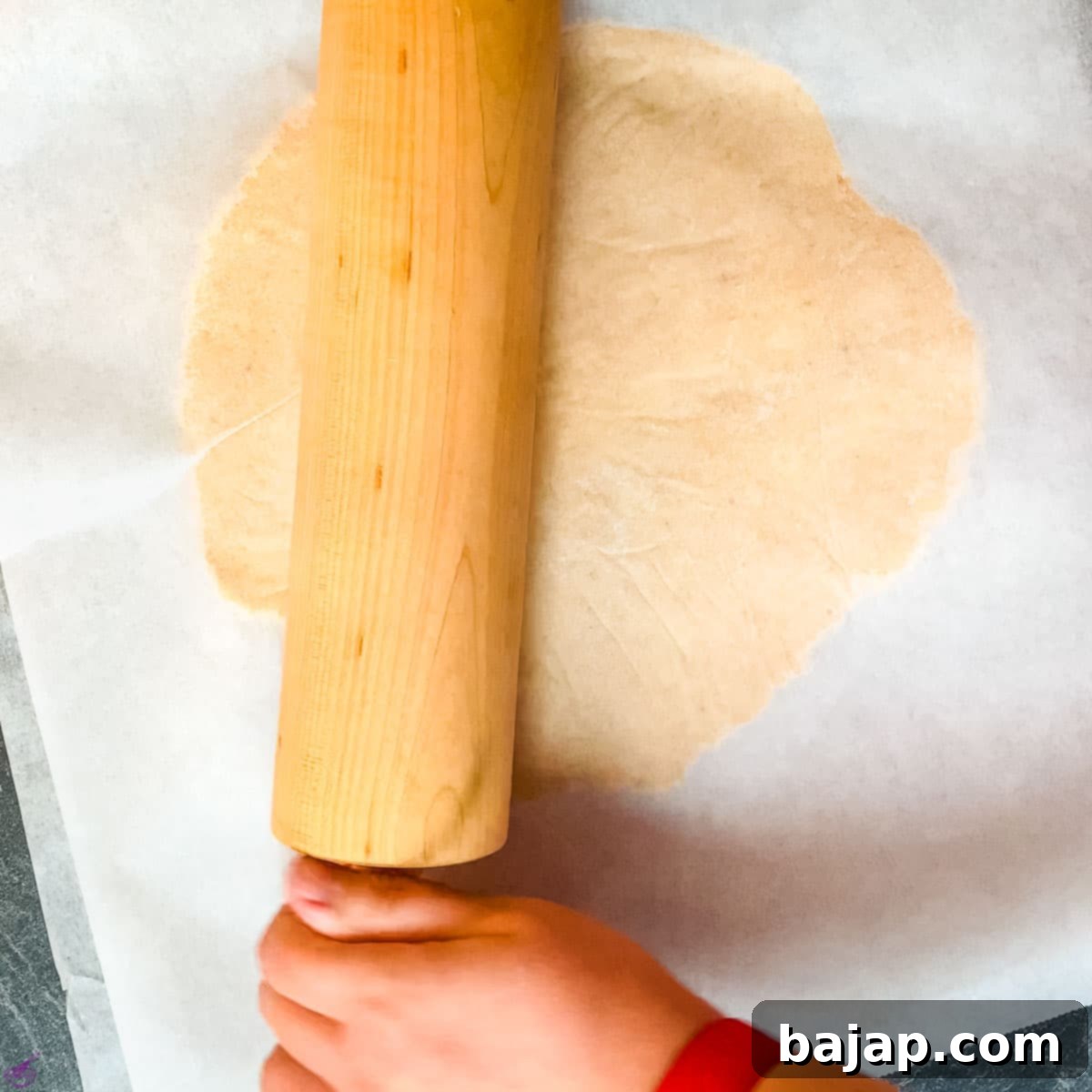
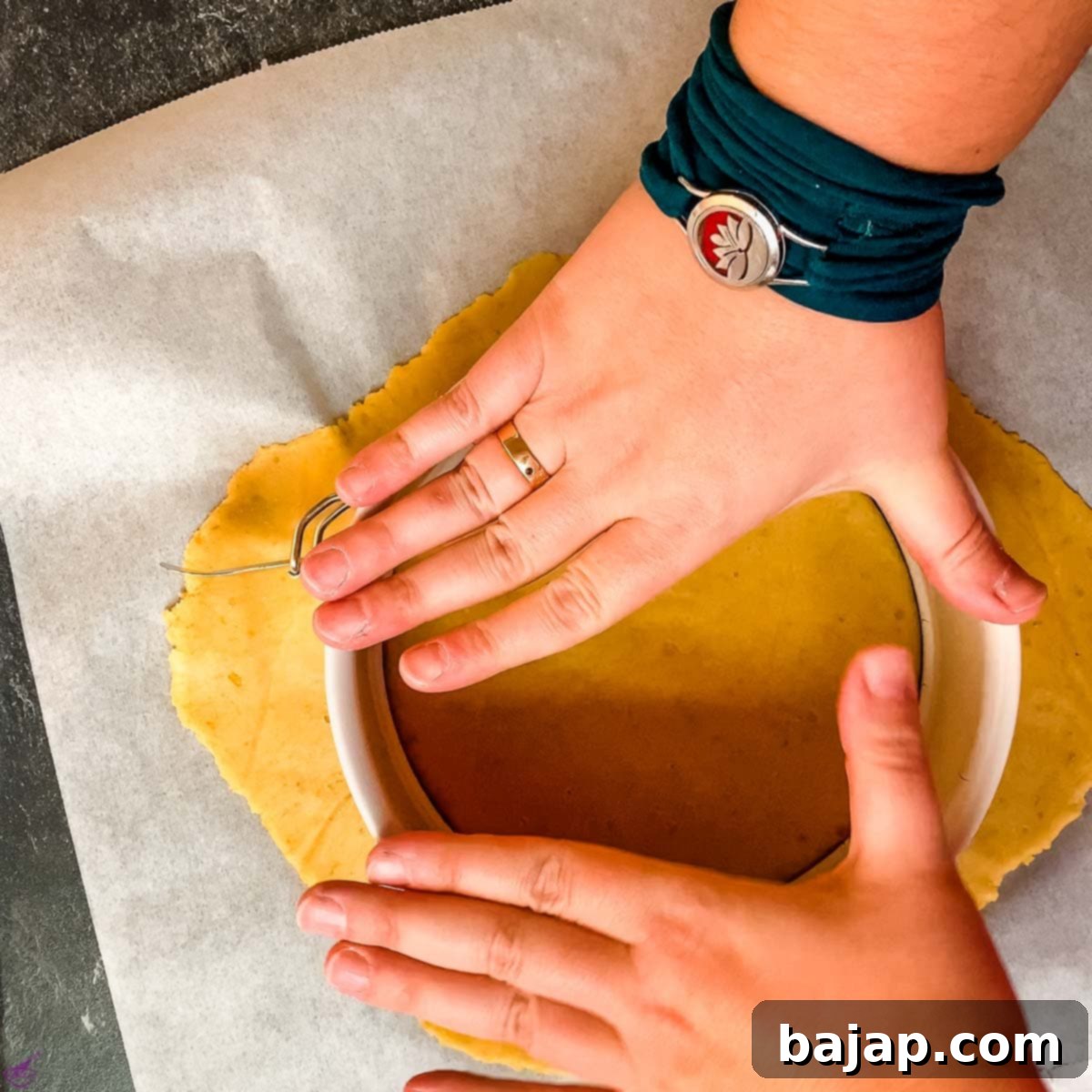
- **Form the Sidewalls:** Use the second ball of chilled tart dough. Roll it out to the same 3-4mm thickness as the base, creating a longer, oval-shaped form. Cut this into strips about 4cm (1.5 inches) wide, or adjust the width to match the height of your tart pan. Carefully line the inner walls of your tart pan with these dough strips, pressing firmly but gently onto the base to ensure a seamless connection all around. This creates the essential structure of your tart shell.
- **Trim & Dock:** Using a sharp knife, carefully trim any excess dough from the top edge of the pan, ensuring a clean, even finish. Next, use a toothpick or a fork to “dock” the base of the tart crust by poking several holes across it. This prevents the crust from puffing up unevenly during baking. Any leftover dough can be wrapped and frozen for future use – perfect for small tarts or decorative cut-outs!
- **Ready to Fill or Blind Bake:** At this stage, your walnut tart crust is ready to be filled with the filling of your choice and baked according to that specific recipe’s instructions. Alternatively, if your recipe requires a pre-baked (or blind-baked) crust, proceed to the following steps.
Optional: Blind Baking Your Walnut Tart Crust (Highly Recommended for Wet Fillings!)
Blind baking is the process of partially or fully baking a pie or tart crust before adding the filling. This is essential for tarts with very wet fillings (like custards or fruit fillings) or for no-bake fillings (like ganache or cream). It helps prevent a soggy bottom and ensures a crisp, evenly cooked crust.
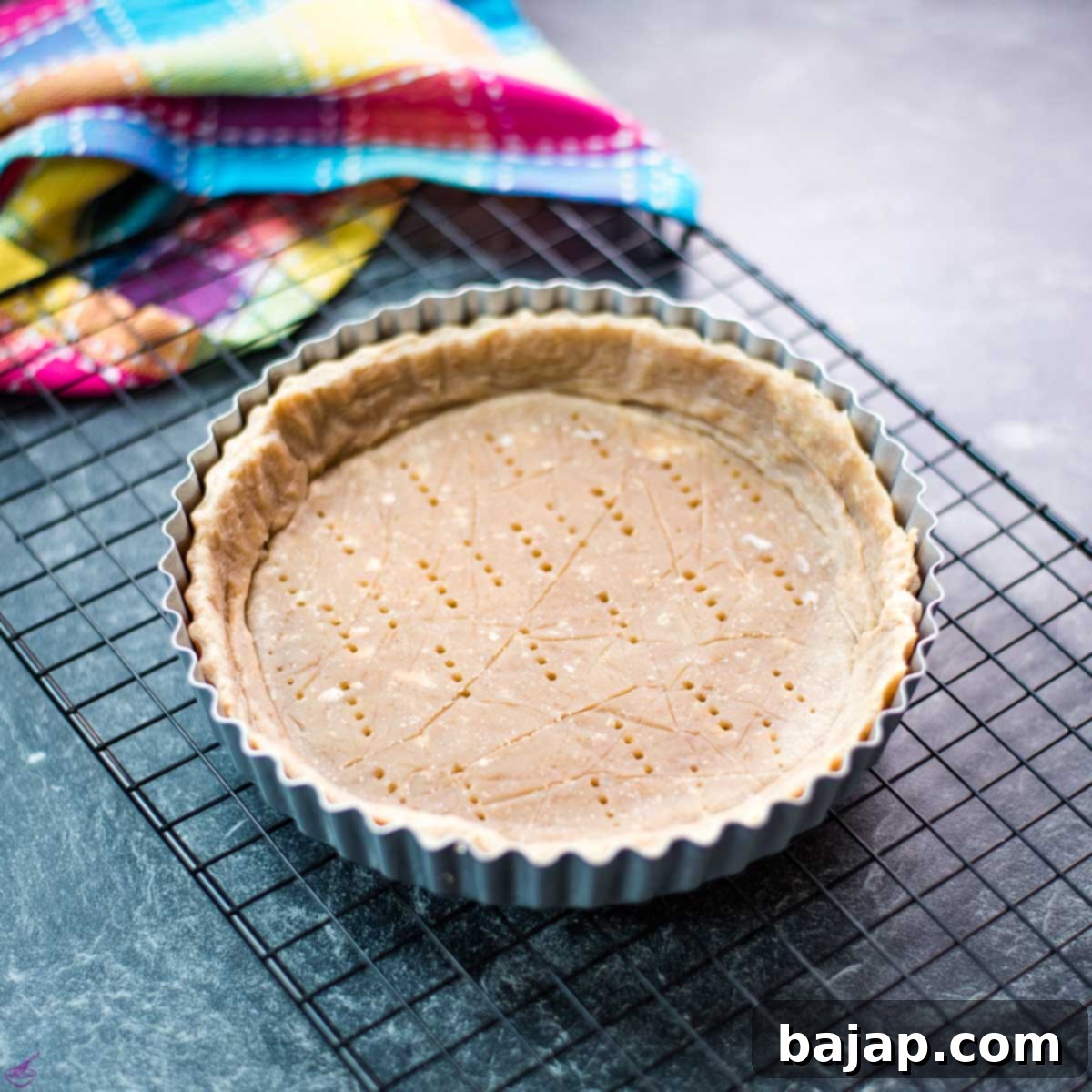
- **Second Chill & Preheat Oven:** Once your tart pan is lined with the dough (base and sidewalls), place it back in the fridge for another 30 minutes. This second chill helps the crust hold its shape better during baking. While it’s chilling, preheat your oven to 180°C (360°F).
- **Prepare for Blind Baking (Optional but Recommended):** To ensure your crust bakes flat and doesn’t puff up or shrink, line the chilled dough with a piece of parchment paper or aluminum foil. Then, fill it with pie weights, dry rice, or dried beans, creating an even layer about 2.5 cm (1 inch) deep. This weight helps prevent the crust from bubbling or shrinking. Remember to remove the weights and parchment/foil before placing the crust in the oven!
- **Bake the Crust:** Bake your chilled, weighted (if using) tart crust for 15 minutes. This initial bake sets the crust. After 15 minutes, remove the weights and parchment/foil, and continue baking for another 5-10 minutes, or until the crust is lightly golden brown and fully cooked through.
- **Cool Completely:** Once baked, remove the tart crust from the oven and let it cool completely to room temperature on a wire rack. This is crucial before adding any filling, as a warm crust can cause fillings to melt or become soggy.
- **Fill & Serve!** Your perfectly baked walnut tart base is now ready for your chosen filling! Whether it’s a luscious ganache, a vibrant fruit custard, or a savory quiche filling, simply pour it in, add your final decorative touches, and serve!
🍑 Delicious Variations for Your Tart Crust
This walnut tart crust recipe is incredibly adaptable! While walnuts provide a distinctive flavor, you can explore other options:
- **Nut Substitutions:** Experiment with other finely grated nuts like pecans, almonds (for a frangipane-like base), or even hazelnuts for a different flavor profile. Each nut will lend its unique characteristics to the final taste.
- **Sweet vs. Savory:** This dough is primarily designed for sweet tarts, but by reducing the icing sugar slightly and perhaps adding a pinch of garlic powder or dried herbs, it can transform into an excellent savory base for quiches, tarts with roasted vegetables, or even mini appetizer tarts.
- **Pan Choices:** While the recipe specifies a tart pan, it can certainly be prepared in a springform pan or even individual tartlet molds for delightful single-serving treats. Adjust baking times accordingly for smaller sizes.
- **Blind Baking Flexibility:** As mentioned, this crust is ideal for recipes where the crust must be “blind baked” – meaning baked fully or partially by itself before the filling is added. This technique is indispensable for achieving a crisp bottom, especially with wet fillings.
🍽 Essential Equipment for Tart Making
Having the right tools makes all the difference when baking. Here’s what you’ll need for this walnut tart crust recipe:
- 9-inch (23 cm) Tart Pan / Cake Pan: A tart pan with a removable bottom is ideal for easy unmolding.
- Rubber Spatula: For gentle mixing and scraping bowls.
- Rolling Pin: Essential for evenly rolling out the dough.
- Hand Mixer (Optional): Can be used for initial butter incorporation, but fingertips are preferred for flakiness.
- Whisk: For combining dry ingredients if not sieving.
- Mixing Bowls: Various sizes for ingredients and dough preparation.
- Parchment Paper: Crucial for rolling out dough and blind baking.
- Oven: For baking your delicious crust.
- Sieve: For lump-free flour and icing sugar.
🌡 Storage & Top Tips for Your Walnut Tart Crust
Proper storage is key to making the most of your homemade tart crust and managing your baking schedule efficiently. Here are some invaluable tips:
- **Storing Excess Dough:** If you have leftover dough, don’t let it go to waste! Wrap it tightly in cling film and store it in the refrigerator for up to three days. For longer storage, the tart dough freezes beautifully for up to three months. Thaw overnight in the refrigerator before using.
- **Pre-Baked Crust Storage:** If you’re blind baking your crust in advance, it can be stored at room temperature (covered loosely) for up to 24 hours or in an airtight container in the refrigerator for up to three days. Always ensure it’s completely cooled before storing.
- **Assembling Ahead of Time:** A golden rule for any tart: avoid combining your baked crust and filling until the day you plan to serve it. This prevents the crust from becoming soggy, preserving its crisp texture and integrity.
- **Leftover Tart Storage:** For a fully assembled tart with filling, storage varies depending on the filling. As a general guideline, plan to enjoy your leftover tart within three days. Always store it in an airtight container to maintain freshness and prevent it from absorbing refrigerator odors. Some tarts, especially those with cream or custard, may require refrigeration.
- **Don’t Waste Those Egg Whites!** This recipe leaves you with several egg whites. Instead of discarding them, freeze them in ice cube trays for later use (one cube typically equals one egg white). They’re perfect for a variety of delicious recipes:
- **6 Egg White Chocolate Cake:** A light and airy chocolate cake, perfect for using up those whites.
- **Cinnamon Cookies:** Delicate and crisp cookies that often utilize egg whites for texture.
- **Mini Pavlova:** Elegant meringue desserts that are all about whipped egg whites.
- **Walnut Meringue Cookies:** A wonderful way to combine leftover walnuts and egg whites into delightful treats.
- **Coconut Cookies:** Chewy and flavorful, another excellent option for using egg whites.
🙋🏻 Frequently Asked Questions About Tart Crusts
While often used interchangeably in casual conversation, pie crusts and tart crusts have distinct characteristics. One of the main differences is typically the thickness: tart crusts are generally thicker and firmer than pie crusts, designed to stand alone without the support of a pie plate, often featuring a decorative edge. Unlike most pies, which are covered with a top crust, tarts traditionally only have a bottom crust, showcasing their beautiful fillings. Additionally, tart dough often contains sugar, giving it a slightly sweeter profile suitable for desserts.
A basic tart crust, often called a “pâte sablée” (sandy dough) or “pâte sucrée” (sweet dough), is typically made from a foundation of all-purpose flour, sugar (often icing sugar for a finer crumb), salt, cold butter, and usually egg yolks (sometimes a whole egg) and a touch of water. Our recipe takes it a step further by incorporating finely grated walnuts, which infuse the crust with a wonderful nutty flavor and a slight textural variation, making it a unique and delightful base for any tart.
No, a tart crust and a puff pastry crust are made with fundamentally different types of dough and are used for different purposes. Our walnut tart crust recipe uses a shortcrust pastry, which is rich in butter and sugar, resulting in a crisp, tender, and somewhat crumbly texture. Puff pastry, on the other hand, is made by repeatedly folding butter into a simple flour-and-water dough, creating hundreds of thin layers that puff up dramatically when baked. Puff pastry is typically rolled very thin and is used for both sweet and savory items where a light, airy, and extremely flaky texture is desired (like croissants or vol-au-vents), whereas tart crusts provide a more robust and substantial base.
Technically, yes, you can often substitute a store-bought pie crust for a tart crust in a pinch, and the recipe will likely still work. However, the results will differ. Pie crusts tend to be less sweet and have a flakier, less crumbly texture, often designed to be less rigid than a tart crust. If your recipe specifically calls for a tart crust, it’s usually because it relies on the tart crust’s sturdiness and slightly sweeter, richer flavor to complement the filling. If the tart crust, like our walnut version, contributes a significant flavor component to the dish, sticking with the specified tart crust will undoubtedly yield a superior and more authentic result.
Chilling the tart dough is a critical step that serves multiple purposes. Firstly, it allows the gluten, which is developed during mixing, to relax. This relaxation prevents the dough from shrinking excessively when baked, ensuring your crust retains its intended size and shape. Secondly, chilling solidifies the butter within the dough. When the cold butter melts in the hot oven, it releases steam, creating tiny pockets that contribute to a flaky and tender texture. Lastly, cold dough is much easier to handle and roll out without becoming sticky or tearing, making the entire process smoother and more enjoyable.
If you create this incredible walnut tart crust, please let me know how much you enjoyed it by leaving a ★★★★★ star rating and a comment below! Your feedback is invaluable and truly appreciated. You can also sign up for our Newsletter to receive delicious homemade recipes weekly, or follow me on Pinterest or Instagram and share your creation with me. Just tag me @combinegoodflavors and use the hashtag #combinegoodflavors, so I don’t miss it!
📖 Recipe
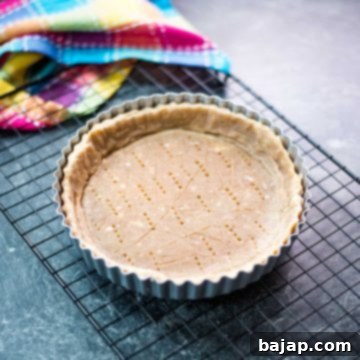
Walnut Tart Crust: Flaky & Flavorful
Nora
Save RecipeSaved!
Pin Recipe
Equipment
-
Tart Pan / Cake Pan 9 inch / 23 cm, preferably with a removable bottom
-
Rubber spatula
-
Rolling Pin
-
Whisk or hand mixer
-
Mixing bowls various sizes
-
Parchment Paper
-
Oven
-
Sieve
Ingredients
- 3 cups All-Purpose flour sieved
- ¼ cup Icing sugar
- 1 teaspoon Salt
- 1 cup Butter unsalted, very cold and cubed
- ¼ cup Walnuts finely grated
- 4 Egg Yolks
- ½ cup Water ice cold
Instructions
-
Sieve 3 cups All-Purpose flour and ¼ cup Icing sugar into a large mixing bowl, ensuring they are light and lump-free.3 cups All-Purpose flour, ¼ cup Icing sugar
-
Create a well in the center of the flour mixture, resembling a small volcano, and add 1 teaspoon Salt.1 teaspoon Salt
-
Cut 1 cup of very cold, unsalted Butter into small cubes and place them in the center well.1 cup Butter
-
Using your fingertips, quickly work the flour into the cold butter, squeezing the cubes until the mixture resembles coarse breadcrumbs. The butter should be fully mixed but not melted.
-
Form another well in the center. Add 4 Egg Yolks, ¼ cup finely grated Walnuts, and ½ cup ice-cold Water.¼ cup Walnuts, 4 Egg Yolks, ½ cup Water
-
Gently bring all ingredients together to form a dough. Be careful not to overwork it, as this can lead to a tough crust. A kitchen machine on low speed can also be used.
-
Divide the dough into two equal balls, flatten slightly into discs, wrap tightly in cling film, and chill in the fridge for at least 1 hour. This resting period is crucial for texture and ease of handling.
-
After chilling, roll out one dough disc between two sheets of baking paper to an even thickness of 3-4mm (0.1 inch). Use the tart pan base as a guide to cut out the bottom, then carefully transfer it to your tart pan.
-
Roll out the second dough disc to the same thickness. Cut strips approximately 4cm (1.5 inches) wide, or to the height of your tart pan, to form the sidewalls. Press these strips firmly onto the base to connect.
-
Trim any excess dough from the top edge with a sharp knife and gently prick the base all over with a toothpick or fork (docking). Reserve any excess dough for future use by freezing.
-
At this point, you can fill the crust with your chosen filling and bake according to that recipe, or follow the “Pre-Bake Crust” steps below for a blind-baked shell.
Pre-Bake Crust (Blind Baking)
-
After lining your tart pan with the dough, chill the formed crust in the fridge for another 30 minutes. Meanwhile, preheat your oven to 180°C (360°F).
-
To prevent puffing and shrinkage, line the chilled crust with parchment paper or aluminum foil, and fill with pie weights (or dry rice/beans) to about 2.5 cm (1 inch) deep.
-
Bake for 15 minutes with weights. Then, remove weights and parchment/foil, and continue baking for another 5-10 minutes, or until the crust is golden and firm.
-
Let the baked tart crust cool completely to room temperature on a wire rack before filling. This ensures a crisp base.
-
Your pre-baked walnut tart base is now ready for your desired ganache, custard, or no-bake filling! Add final decorative touches and serve.
Nutrition values are estimates only, using online calculators. Please verify using your own data.

🤎 You Might Also Like These Sweet Delights
If you loved creating this versatile walnut tart crust, you’ll surely enjoy exploring other delicious baking projects. Here are some of our favorite recipes that pair perfectly with a homemade crust, or offer a different kind of sweet treat to hone your baking skills:
- Old-fashioned Whipping Cream Bundt Cake
- Potato Flour Cake with Eggnog
- Delicious 6 Egg White Chocolate Cake
- Flourless Chocolate Cake
⛑️ Food Safety First
Ensuring food safety is paramount in any kitchen. Please keep these guidelines in mind while preparing this or any recipe:
- Cook all food to its minimum safe internal temperature. For most poultry, this is 165°F (74°C). While this recipe doesn’t involve raw meat, it’s a good general rule for other dishes.
- Always use separate utensils and cutting boards for raw ingredients and cooked food to prevent cross-contamination.
- Thoroughly wash your hands with soap and hot water after handling any raw ingredients, especially eggs or nuts that may carry bacteria.
- Avoid leaving perishable food, like dough or filled tarts, sitting out at room temperature for extended periods (generally no more than two hours).
- Never leave cooking food unattended on the stove or in the oven.
- When cooking at high temperatures, use oils with a high smoking point to avoid the production of harmful compounds.
- Ensure good ventilation when using a gas stove or oven to maintain air quality in your kitchen.
For further comprehensive information on safe food handling practices, please refer to the Safe Food Handling – FDA guidelines.
